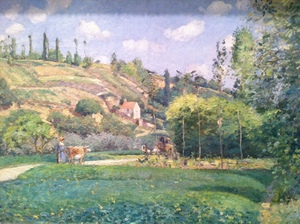Pissarro
Passages: Pissarro
Sunday, November 24, 2013

Pissarro, Pontoise, Road to Gisors in Winter, 1873, MFA.
Camille Pissarro, theorist and mentor of the Impressionist movement, was known for giving sound advice. Here are some of his thoughts as later recollected by the painter Louis Le Bail (in Rewald, The History of Impressionism). They’re in the order that Le Bail wrote them down in, but I’ve broken them into territories, and set them to some iphone details I took of the last Pissarro I looked at, Pontoise, the Road to Gisors in Winter, 1873, at the Museum of Fine Arts in Boston:
Look for the kind of nature that suits your temperament.
The motif should be observed more for shape and color than for drawing. There is no need to tighten the form which can be obtained without that. Precise drawing is dry and hampers the impression of the whole, it destroys all sensations. Do not define too closely the outlines of things; it is the brush stroke of the right value and color which should produce the drawing.

In a mass, the greatest difficulty is not to give the contour in detail, but to paint what is within. Paint the essential character of things, try to convey it by any means whatsoever, without bothering about technique.

When painting, make a choice of subject, see what is lying at the right and at the left, then work on everything simultaneously. Don’t work bit by bit, but paint everything at once by placing tones everywhere, with brush strokes of the right color and value, while noticing what is alongside. Use small brush strokes and try to put down your perceptions immediately.

The eye should not be fixed on one point, but should take in everything, while observing the reflections which the colors produce on their surroundings. Work at the same time upon sky, water, branches, ground, keeping everything going on an equal basis and unceasingly rework until you have got it. Cover the canvas at the first go, then work at it until you can see nothing more to add.

Observe the aerial perspective well, from the foreground to the horizon, the reflections of sky, of foliage.
Don’t be afraid of putting on color, refine the work little by little.
Don’t proceed according to rules and principles, but paint what you observe and feel.

Paint generously and unhesitatingly, for it is best not to lose the first impression.
Don’t be timid in front of nature: one must be bold, at the risk of being deceived and making mistakes.
One must have only one master – nature; she is the one always to be consulted.





